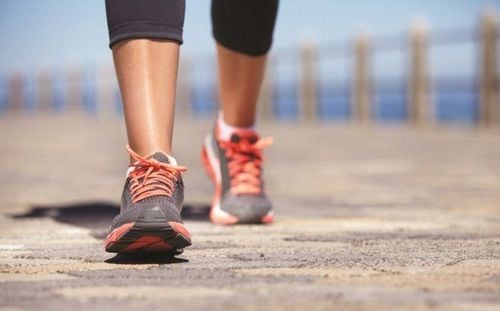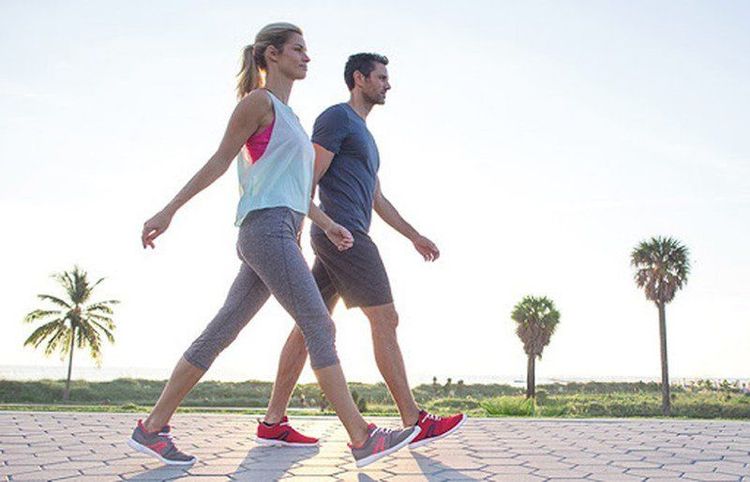This is an automatically translated article.
Losing weight is not difficult, you can lose weight the way you walk, depending on how long and how intense you walk and how your diet is. The combination of physical activity and cutting calories seems to result in more weight loss than just walking. In this article will help you better understand the role of walking in your weight loss plan.1. Will walking alone lose weight?
Physical activity, such as walking, is important for weight control because it helps you burn calories. If you add 30 minutes of brisk walking to your daily routine, you can burn about 150 more calories per day. Of course, the more you walk and the faster the pace, the more calories you burn.However, balance is important. Overusing it can increase the risk of soreness, injury, and burnout. If you're new to regular exercise, you may need to start with short or light-intensity walks, and work your way up to longer or more moderate-intensity walks.
Once you've lost weight, exercise is even more important. That's what helps with weight loss. In fact, studies show that people who maintain long-term weight loss are physically active.
So keep walking, but make sure you also eat a healthy diet.
Walking can help us lose weight, and regular exercise plays an important role in helping to maintain effective weight loss. Regular exercise like walking not only helps increase the amount of energy the body burns daily, but also helps us build more lean muscle to burn more calories, even at rest. What's more, engaging in regular, moderate-intensity exercise like walking can improve a person's mood, making them more likely to stay active longer.
A recent review estimates that to maintain a healthy weight, we should spend at least 150 minutes walking each week. However, if we want to lose more weight, we may need to exercise more than 200 minutes per week to prevent ourselves from gaining weight back. In fact, studies have found that people who exercise a lot are most often successful in maintaining their weight loss, while those who exercise are less likely to return to their original weight. head. Incorporating more walking during the day can help increase exercise intake and contribute towards daily activity goals.

Giảm cân không khó, bạn có thể giảm cân theo cách đi bộ, tùy thuộc vào thời gian và cường độ bạn đi bộ và chế độ ăn uống của bạn như thế nào
2. What can walking bring to your health?
If you want to stay in shape and stay healthy, it's important to exercise regularly. This is because physical activity reduces the risk of developing health conditions such as metabolic cardiovascular disease, type 2 diabetes, and cancer. In addition to helping us live longer and healthier lives, exercise can also be beneficial for weight loss and maintaining a healthy weight. Fortunately, walking is a great form of physical activity that is free, low-risk, and accessible to most people.In fact, walking is not only good for us, it is also one of the easiest forms of exercise to incorporate into one's daily life. Here are the health benefits that walking can give us:
2.1. Walking burns calories Our bodies need energy (in the form of calories) for all the complex chemical reactions that allow for normal movement, breathing, thinking, and functioning. However, daily calorie requirements vary from person to person and are influenced by a number of factors such as an individual's weight, gender, genetics, and activity level.
Everyone knows that our bodies need to burn more calories than they consume in order to lose weight. What's more, people who are more physically active will burn more calories than those who are less physically active or only low in activity. However, the modern living and working environment can make us spend most of the day sitting, especially for those who do office jobs. Unfortunately, a sedentary lifestyle not only contributes to weight gain but can also increase the risk of other health problems like cardiovascular disease, diabetes....

Cố gắng tập thể dục nhiều hơn bằng cách đi bộ thường xuyên hơn có thể giúp cơ thể đốt cháy nhiều calo hơn
2.2. Walking improves muscle endurance When people cut calories and lose weight, they often lose some muscle in addition to body fat. However, it can be counterproductive, as muscle is more metabolically active than fat, meaning muscle helps us burn more calories each day. Exercise, including walking, can help counteract this effect by maintaining lean muscle mass while weight loss is still being practiced, which can help lower the metabolic rate that often occurs. when it comes to weight loss, helps maintain longer lasting weight loss results
Furthermore, it can reduce age-related muscle loss, helping us retain more muscle strength and function, even when have age.
2.3. Walking helps burn belly fat Effectively storing a lot of fat around the belly area of the body has been linked to an increased risk of diseases like type 2 diabetes and heart disease. In fact, men with a waist circumference greater than 40 inches (about 102 centimeters) and women with a waist circumference greater than 35 inches (about 88 centimeters) have abdominal obesity, which is considered a potential health risk. One of the most effective ways to lose belly fat is to regularly engage in aerobic exercise, such as walking or jogging. In a recent study, obese women who walked for 50-70 minutes three times per week for 12 weeks lost an average of 1.1 inches (about 2.8 centimeters) in waist circumference and 1 .5% body fat, especially belly fat. Another study found that people who followed a calorie-controlled diet, walking for an hour five times per week for 12 weeks lost an extra 1.5 inches (about 3.7 centimeters) in their waist circumference and by an extra 1. 3% more body fat, compared to people following this diet alone. In addition, other studies on the effects of brisk walking for 30-60 minutes a day have shown similar results.

Đi bộ giúp bạn đốt cháy mỡ bụng hiệu quả
Furthermore, some studies have found that if we enjoy a physical activity, it can increase the likelihood that we will continue doing it. People tend to exercise less if they don't enjoy doing so, which may be the result of exercise being too physically demanding. Walking therefore becomes a great choice as it is a moderate intensity exercise. That can motivate a person to walk more instead of giving up.
2.5. How to incorporate walking into everyone's lifestyle More physical activity has many benefits, including improved fitness and mood, reduced risk of disease and increased likelihood of living a longer, healthier life. stronger. Therefore, everyone should participate in at least 150 minutes of moderate-intensity exercise each week.
In exercise walking terms, that means walking for about 2.5 hours per week (at least 10 minutes at a time) at a brisk pace. Exercising more than this is beneficial for health and reduces the risk of disease even more.

Theo thuật ngữ đi bộ tập thể dục, điều đó có nghĩa là đi bộ khoảng 2,5 giờ mỗi tuần (ít nhất 10 phút mỗi lần) với tốc độ nhanh
Use a fitness tracker and record your total steps and speed achieved to motivate yourself to move more. Make it a habit to take a brisk walk on your lunch break or after dinner. Invite a friend to go for an evening walk. Make it a habit to take your dog for a daily walk or walk with someone else. Join a walk-in meeting with a coworker, instead of meeting at a desk. Do errands like taking your kids to school or walking to the store. Walk to work. If it's too far, park further away or get off the bus a few stops early and walk the rest of the way. Try out new and challenging routes to keep your hike enjoyable. Join a walking group. Everything counts, so start small and try to gradually increase the number of steps you take each day. Walking is a moderate-intensity exercise that can be easily incorporated into our daily lives. Just walking more often can help you lose weight and belly fat, as well as provide other great health benefits, including reduced risk of disease and improved mood. In fact, just walking a mile burns about 100 calories. If you want to lose weight, you'll get the best results by combining increased physical activity with healthy changes in your diet.
Hope the above information has provided you with more options and answers if only walking can help you lose weight. Wish you always have a scientific diet and improve your work productivity and improve your life.
Please dial HOTLINE for more information or register for an appointment HERE. Download MyVinmec app to make appointments faster and to manage your bookings easily.
References: mayoclinic.org, healthline.com












